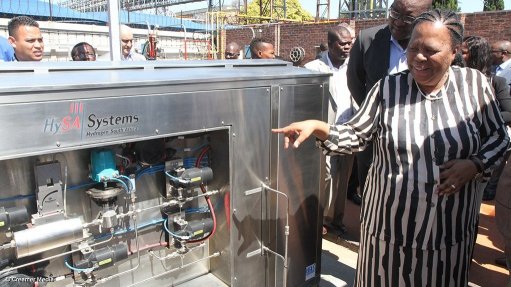
BOLD MOVES Fuel cell technologies have the potential to provide access to affordable, safe, clean and reliable energy
In spite of the current costs involved in the production of fuel cells, platinum producer Impala Platinum (Implats) is positive that the deployment and uptake of the technology will improve its affordability, noting that fuel cells are following the same cost trajectory as solar power.
Implats fuel cell coordinator Fahmida Smith tells Mining Weekly that the current cost of capital is a challenge, but that platinum demand is expected to rise in the short to medium term through an uptake of fuel cells in the stationary applications and the mining and materials handling sectors. “Fuel cells are following the same cost trajectory as solar power, when the technology was first deployed. “As the uptake improves, the cost will come down.”
Implats in March unveiled a hydrogen fuel cell forklift and hydrogen refuelling station in the presence of Science and Technology Minister Naledi Pandor and Gauteng Premier David Makhura at the Impala Refineries, in Springs.
Mining Weekly reported in May that the R12-million initiative, undertaken in partnership with the University of the Western Cape, focuses on building local skills in the development of platinum-containing fuel cells.
Under the leadership of CEO Terence Goodlace, Implats is taking firm strides to help establish fuel cells on a commercial footing, which would positively impact on demand for the metal.
Implats is at an advanced stage of studying the feasibility of taking its entire platinum refinery off the national electricity grid and powering it with platinum fuel cells.
Implats’ short- to medium-term plan foresees a future demand for stationary applications and niche mobile markets, such as materials handling and mining equipment, while its medium- to long-term plan predicts that fuel cell electric vehicles will be the driving force behind future platinum demand.
The platinum producer employs a financial model that needs to “make sense” before a project is considered viable.
“Our projects of interest are considered on a case-by-case basis and include a breakeven point,” Smith notes.
Implats stationary fuel cell projects are considered over a 20-year power purchase period and are deemed viable when they show a positive return over the period, compared with the estimated cost of electricity over the same period.
Although Smith highlights the potential use of stationary fuel cells for off-grid power generation, she notes that the technology can also be used for grid power and works well for distributed generation – the production of energy close to its point of use.
“Fuel cells are potentially portable and have a small footprint. It is easy to establish a fuel cell if supportive infrastructure is in place,” Smith notes.
The Department of Energy’s (DoE) National Development Plan (NDP) envisages that, by 2030, South Africa will have an adequate supply of electricity and liquid fuels to ensure that economic activity and the welfare of the country are not disrupted, and that at least 95% of the population will have access to grid or off-grid electricity.
Smith believes that fuel cells could help the DoE achieve the NDP’s aim to supply 20 000 MW of the additional 29 000 MW of electricity the country needs by 2030 through gas and other renewable resources like wind, solar and hydroelectricity, which the department sees as viable alternatives to coal.